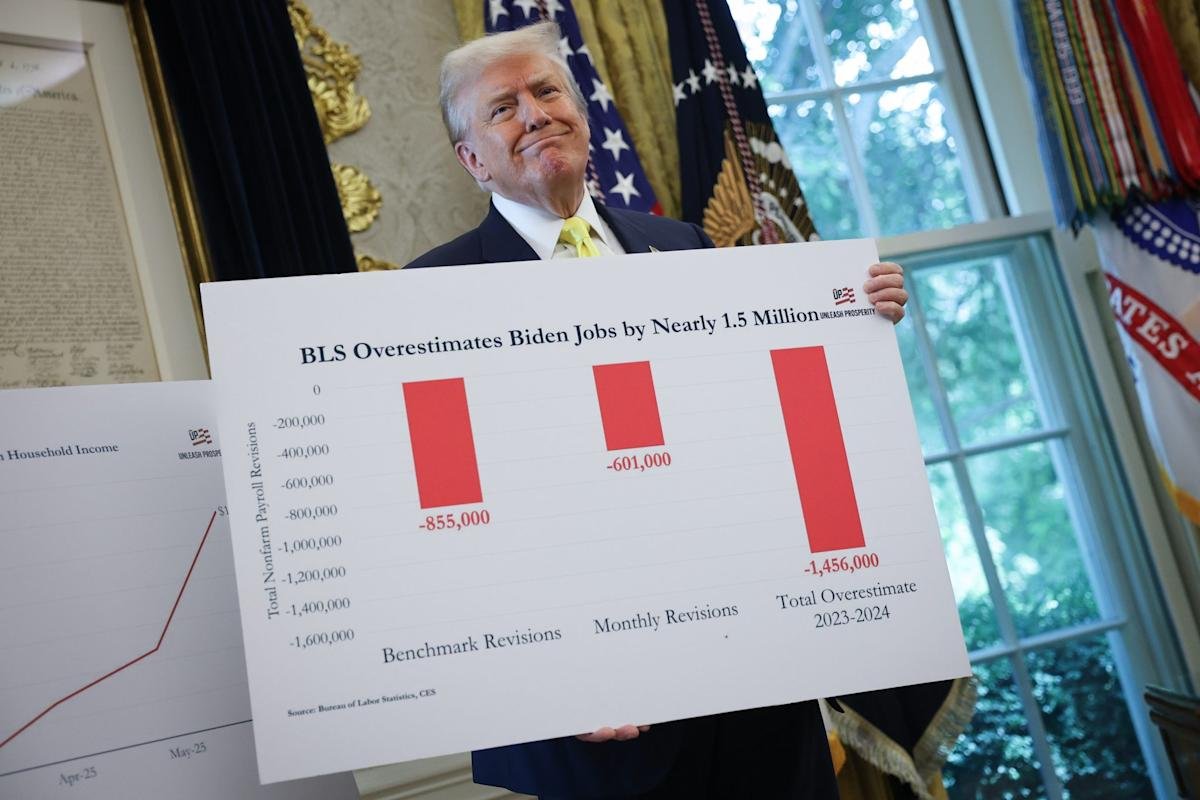For decades, statistics that came directly from the U.S. government, especially from agencies like the Bureau of Labor Statistics (BLS), have long been the gold standard for measuring the health of the American economy. But this trust has been shaken by recent events, including substantial downward revisions to jobs data, bruising political accusations, and the unceremonious dismissal of Erika McEntarfer, the BLS’s top official, at the beginning of the month. The resulting uncertainty has left many Americans asking: If official government data can’t be trusted, how can you know if the economy is struggling?
For decades, regular reports from the BLS and other agencies have offered a detailed portrait of economic activity, from employment levels to inflation to productivity. Businesses, investors, and policymakers depend on these numbers to make informed decisions. But collecting this data is an imperfect, daunting task, particularly in an economy as large and fast-moving as that of the U.S.
The most recent jobs report underscored this difficulty. Initially, BLS figures showed moderate job growth. But after significant downward revisions, the numbers painted a far bleaker picture: Job growth was much weaker than what was previously reported, with the pace of job creation weaker than it’s been in decades, excluding the pandemic-era years. Such revisions are common but usually not this dramatic, and the political repercussions—especially President Donald Trump’s firing of the BLS commissioner and claims of political tampering—have further fueled doubt, criticism, and confusion.
So this invites the question: If you cannot trust official numbers, what concrete signs reveal economic trouble? Economists point to several alternative indicators that, individually and collectively, offer insight—often visible without needing to consult official statistics. Here are the telltale signs the average person, or a skeptical observer, should watch for.
Even in the absence of official jobs figures, warning signs often emerge in the labor market:
More visibly unemployed people: Lines lengthening at job centers, more “help wanted” signs vanishing, and rising rates of layoffs reported by major companies.
Wage stagnation: If you and those around you are not receiving raises, or if companies pull back on hiring bonuses and perks, it often reflects broader malaise.
Surge in part-time or gig work: In downturns, full-time jobs often give way to part-time or contract gigs, sometimes observable through employer and media reports.
The everyday economy leaves trails in consumer behavior and community life:
Reduced spending: Noticeable drops in traffic at restaurants, shops, and malls; fewer people traveling or eating out; increased coupon clipping and price sensitivity.
Rising defaults: More “for sale” and “foreclosure” signs, growing anecdotes of evictions or missed payments, and upticks in bankruptcies reported by courts and real estate boards.
Charity demand: Food banks, shelters, and local charities may report higher demand, sometimes before the effects register in official figures.
Businesses are often quicker than government statistics to reflect trouble:
Layoff announcements: Corporate press releases, layoff tracker websites, and industry newsletters provide early warnings about sectors in distress.
Inventory and discounting: Retailers stuck with excess unsold goods may start offering steeper discounts or holding clearance sales.
Small-business closures: More empty storefronts, business liquidations, or community announcements about long-standing establishments shutting their doors.
When government data falters, or is mistrusted, private sector and international organizations’ indices become invaluable:
ADP private payroll data: While not always fully aligned with BLS figures, private payroll processors like ADP provide independent snapshots of employment trends.
Human Development Index (HDI) and Genuine Progress Indicator (GPI): These composite measures integrate health, education, and income measures to provide a broader sense of economic well-being. States such as Maryland and Vermont have implemented GPI to supplement GDP, for example, to offer more nuanced local insights.
Well-being indexes and social metrics: Life expectancy, educational attainment, and even poll-based “happiness” measures often capture public sentiment and living standards in ways GDP and job tallies alone cannot.
Media and social media can be canaries in the coal mine: When headlines become dominated by stories of job losses, business failures, or personal financial hardship, it usually signals real underlying distress, even if official data has not yet caught up.
It’s understandable to be skeptical of government data, especially in the current climate. But it’s important to understand the economy is more than just a set of aggregated numbers. There will be plenty of warning signs if things are trending downward, from empty storefronts to rising bankruptcy rates to visible community distress. So if you don’t feel as if you can rely exclusively on official figures, experts advise keeping your ears to the ground: Pay attention to local businesses, listen to stories from regular people, and keep track of movement in the private sector. The telltale signs are rarely hidden; they are, for better or worse, all around us.
For this story, Fortune used generative AI to help with an initial draft. An editor verified the accuracy of the information before publishing.
This story was originally featured on Fortune.com

